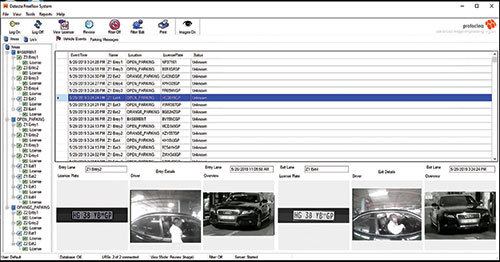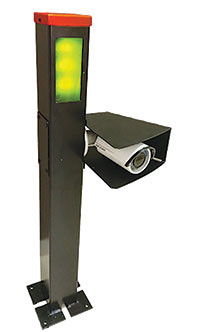

One of the key selling points of residential estates is the safety and protected environment that they offer. However, despite this protected environment, residential estates still experience loss of vehicles and a risk of uncontrolled criminal access, even though there are security measures in place.
When addressing this issue by upgrading security protocols, methods implemented often negatively impact the residents of the estates. A key example of this, with specific reference to upgrades in vehicle access security measures, is the long queues often experienced during peak traffic periods. This results in residents experiencing unnecessary frustration and loss of precious time.
The key question that we would like to address is: can technology offer a cost-effective solution that will provide both secure access control for vehicles and free flow of traffic through the gates, even during peak traffic periods? Fortunately, the answer is yes.
A need for accurate vehicle identification
Traditional solutions generally incorporate the presence of a security guard at the entrance and exit gates. The guard is required to scan the driver’s licence and the vehicle’s licence disc and to conduct a physical security inspection. These steps allow the guard to verify that the vehicle is considered safe to enter or exit the premises if no suspicious or illegal activity is observed. This access control procedure has a clear disadvantage in terms of time, as it is a relatively time-consuming process. A second disadvantage is that there is always a possibility of human error, or bribery.
A more modern solution allows vehicle identification through the use of ANPR (automatic number plate recognition) systems. In this case, the number plate is read and linked to the vehicle in question upon entering the premises. Currently, many ANPR cameras are available, although the accuracy of such systems varies. When researching different options, be sure to look for the following features:

• A database that holds not just the number plate, but also additional information such as vehicle make, model and colour.
• Accurate ANPR that works in poor light, especially in areas where the sun rises or sets directly in line with the camera.
• Accurate ANPR at acute angles, so that camera placement is more flexible.
• Accurate ANPR, even with minor character obstructions.
• Upgradability. As with any technology, it is important to use a system that can be expanded or upgraded, without having to replace everything.
• For multiple-lane systems, centralised processing may significantly reduce costs.
• Ease of use is always important, especially in situations where security personnel might not undergo extensive training.
A need for driver identification
Driver identification can be achieved in several ways. Solutions available range from mechanical devices, such as magnetic tags and RFID, to biometric solutions, such as fingerprint or facial identification. Each solution is associated with its own benefits and disadvantages.
Mechanical devices represent a quick, cost-effective and easily implemented solution to driver identification. Unfortunately, such tags are easy to bypass as driver identification is linked to a tag and not necessarily a person, making them an easy target for theft. These tags are often left in the car for convenient access for the owner/driver and, unintentionally, for thieves.

Biometric solutions are more effective at driver identification but are unfortunately costly at this stage. Facial recognition is an option, but it is relatively expensive and not always accurate. Reflections, sunglasses, and strong lighting contrasts may reduce the accuracy of facial recognition systems. Fingerprint scanning, on the other hand, links the vehicle to the driver’s unique fingerprint. Although such systems are accurate and reliable, they can be bypassed if thieves were to force the owner/driver of the vehicle to allow them to exit the premises. Integrating multiple biometric systems provides a more secure and accurate solution to vehicle access management. A good system will ensure that the driver faces the camera when pressing the button or scanning his/her fingerprint to ensure that a clear image of the driver can be captured.

A need for information integration
The above-mentioned systems are effective in allowing or preventing automatic access or egress; however, additional measures can be implemented to further enhance security. This is done by integrating multiple systems into a single, efficient solution, but this is only possible when different systems are able to communicate and share information freely and efficiently. Thus, information management is imperative to gain maximum benefit from any security system.
The ability to analyse the data collected forms an integral part of all systems mentioned above. Systems that only log entries and provide access cannot be considered good systems, as they are limited in terms of data collection. A good system not only logs entries and provides access, but also incorporates analysis of such events by collecting and analysing data related to the frequency of entries and time of movement, along with other relevant information. Analysis of such data allows the system to flag abnormal access events and alert the security personnel of such events. Further security measures can then be implemented to complement the automated systems, maximising security benefits.
What can new technology offer?
These days, ANPR systems can be ‘smart’. By incorporating machine learning algorithms, access control systems now possess an uncanny ability to detect and identify numbers and letters accurately, even from very poor-quality images. Additional features that further improve such systems is the ability to record and identify vehicle make, model and colour. Additional information is normally entered manually, but cutting-edge systems can now also do this automatically.
New hardware may not be required to add additional identification capabilities to current security systems. If costs are a limiting factor, but a great need for added security exists, there can be an option to integrate new systems with existing systems. A good example of this would be the integration of a new ANPR system with existing boom gates and/or camera systems, saving costs while upgrading and greatly improving the capabilities of the existing system.
Information sharing can greatly improve security in a residential estate. Collecting information on identified vehicles and, where possible, persons entering or exiting the premises and comparing this information against police databases and locally created databases could greatly improve the effectiveness of security systems. Information sharing allows access to data that could alert security personnel to vehicles and/or persons listed as suspicious, allowing security services to act accordingly and alert the proper authorities, thereby ensuring that suitable reaction procedures are followed. The capability to share information with police databases and locally created security databases is well established in South Africa.
Local support
Security systems are manufactured worldwide, and solutions are available at highly competitive prices. However, South Africa has its own unique problems. This means that systems developed elsewhere in the world cannot necessarily address these problems, as manufacturers may not necessarily be aware of the issues faced by South Africans. Therefore, it is recommended that local service providers should be approached first as they are more adept at developing and providing solutions to suit the particular needs of the South African security market. The quality of a security system cannot be determined based solely on its components, i.e., computers and cameras, but is highly dependent on the integration and management software that it runs – this is what separates the men from the boys.
The following checklist outlines features and capabilities that should be taken into consideration when planning to implement a vehicle access control system in a residential estate:
• Are there existing physical access control systems in place, e.g. boom gates?
• Can visitors be handled separately from residents?
• Is the ANPR accuracy sufficient for your requirements?
o Can it deal with acute angles?
o Can it recognise poor-quality images or lighting conditions?
• Can the system record the following details of the access event:
o Picture of vehicle.
o Picture of driver.
º Can the system force the driver to face the camera?
o Make and colour of the vehicle.
o Date and time of the event.
• Does the ANPR system manage the numbers and control access in an organised manner? This includes:
o Pre-registration for residents.
o Pre-registration for visitors.
o Confirm exit with entry.
o Maintain logs of events and ability to analyse status, e.g. verify that vehicles are still in the estate or not, how long they have been there, etc. This is espcially necessary for visitor/delivery vehicles.
• Can the system deal with high traffic conditions?
o Is the recognition process fast and accurate?
• Can the system be used to detect suspicious or blacklisted vehicles and alert security staff?
o Can it integrate to police databases via service providers?
o Can it generate and maintain a local blacklist or whitelist?
• Can the system integrate with other access control solutions? These include:
o Identification document and licence disk scanning.
o RF tags or badges.
o Biometric verification systems such as:
º Fingerprint readers.
º Face identification.
• Can the system be supported?
o Is local support available?
o Can software modifications be made for site-specific applications?
o Can the system be upgraded with improved cameras, algorithms, etc.?
To summarise, it is possible to obtain secure and convenient vehicle access management solutions if:
1. You choose the right product.
2. You understand the capabilities of the product.
3. You have a clear understanding of your needs and take this into consideration when selecting a product.
Dr Coetzer can be contacted at Protoclea Advanced Image Engineering ([email protected], www.protoclea.com), a company specialising in the development of products such as those described in this article.

© Technews Publishing (Pty) Ltd. | All Rights Reserved.